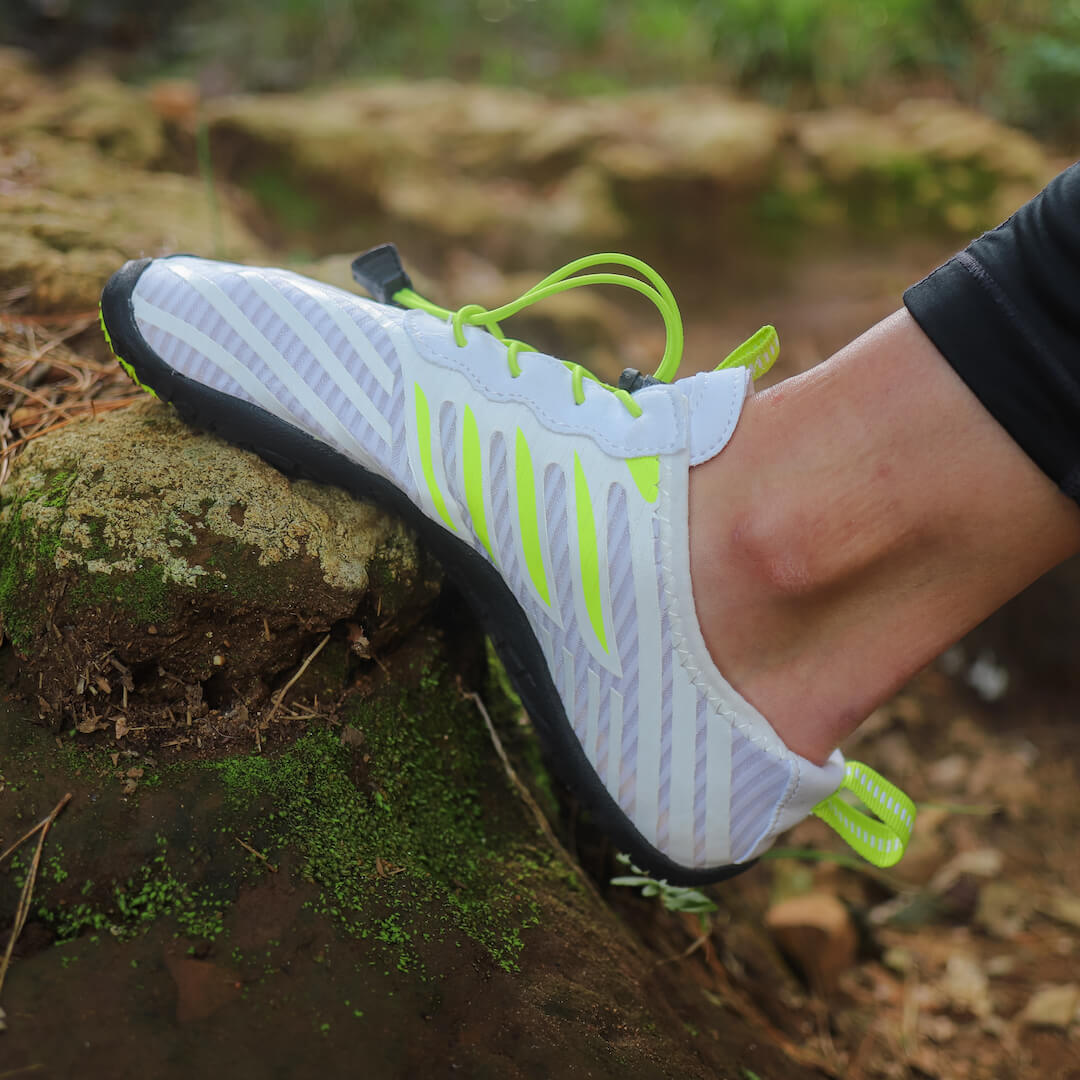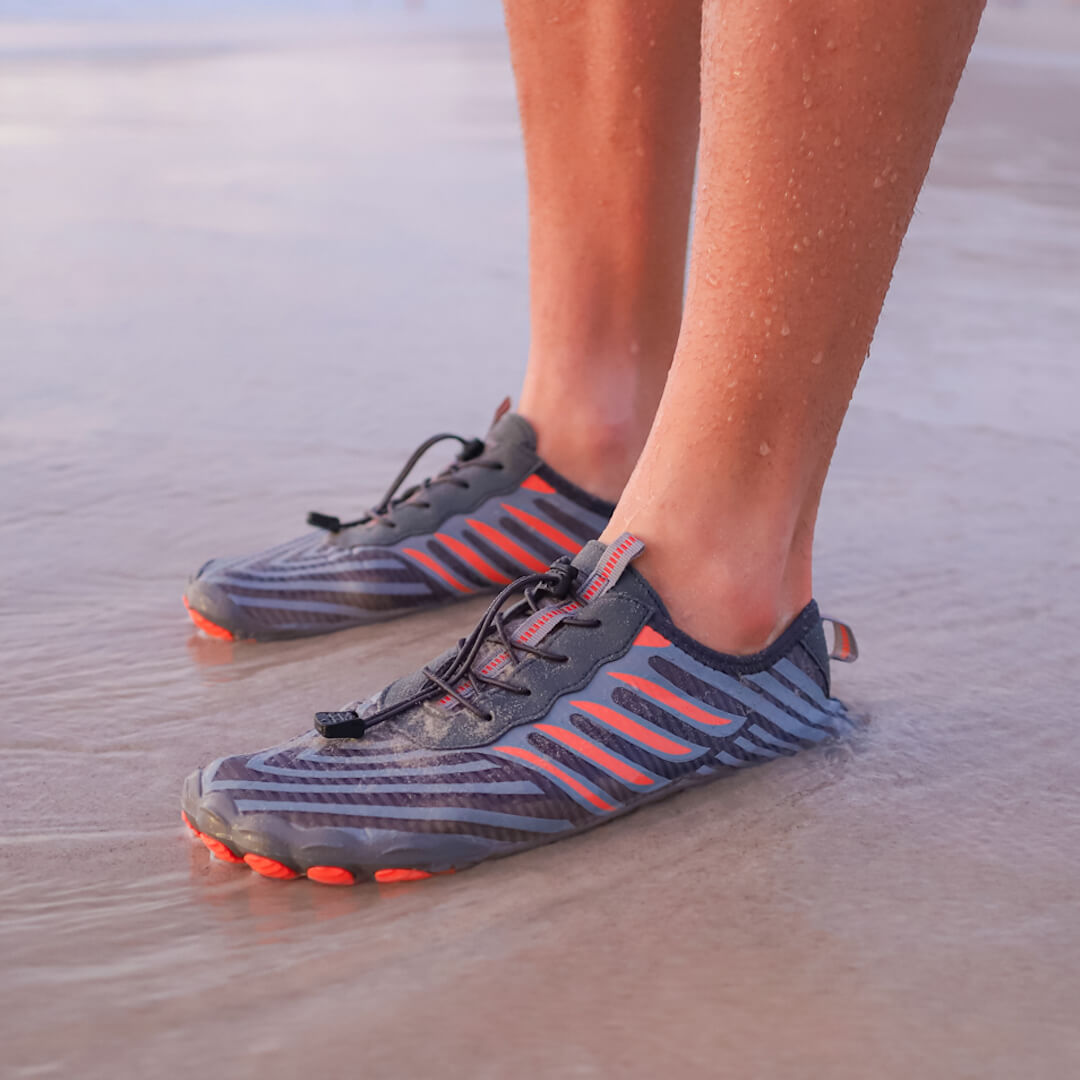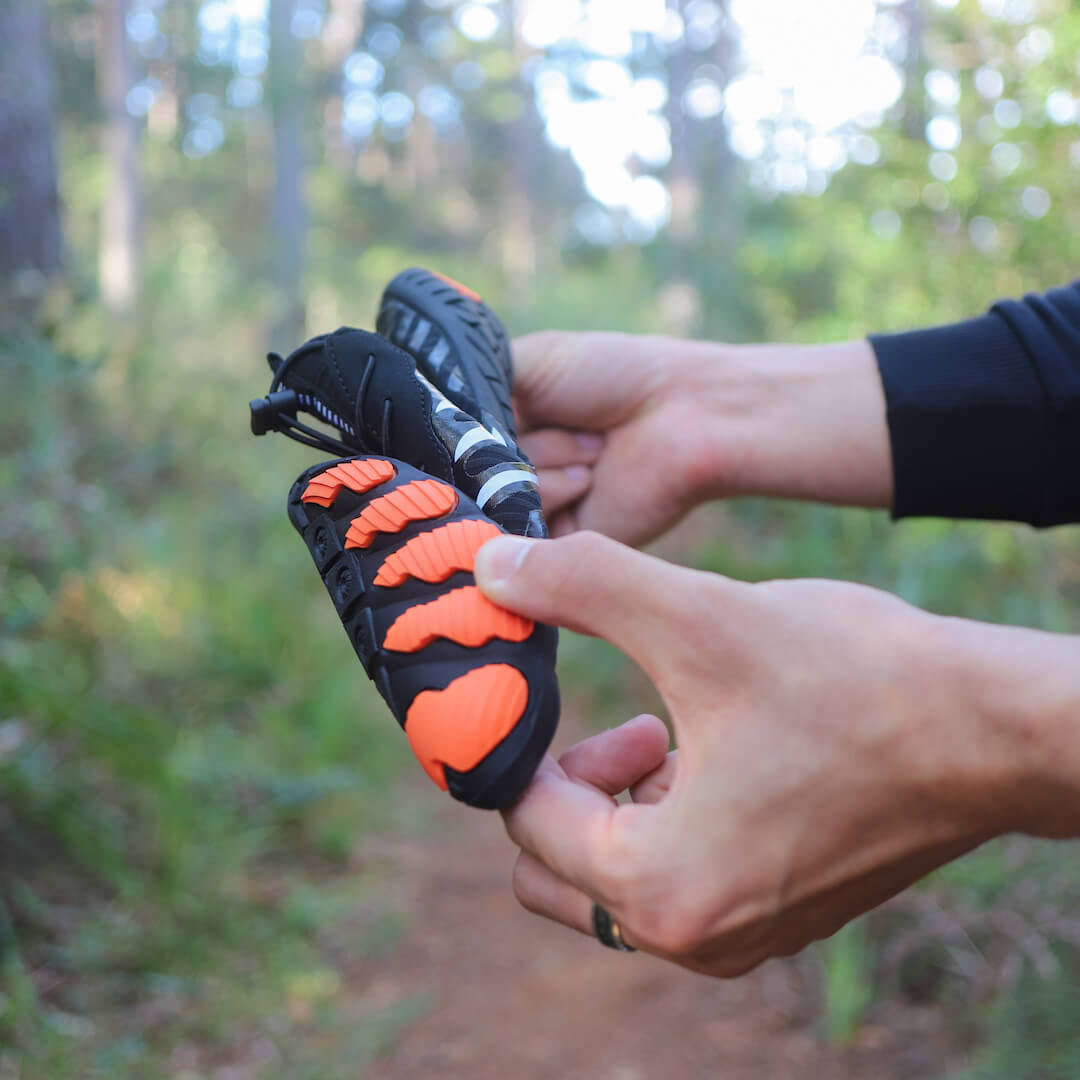Introduction
Welcome to Barestep's blog, where we delve into the fascinating world of barefoot shoes and explore the science behind why they are so good for your feet. If you're tired of the discomfort and limitations that come with traditional footwear, you've come to the right place. Here at Barestep, we are passionate about creating minimalist, comfortable shoes that allow your feet to move naturally and thrive.
In a world dominated by restrictive and often aesthetically-driven shoe designs, it's essential to understand the benefits of barefoot shoes and how they can revolutionize your foot health. By embracing the natural anatomy of your feet, barefoot shoes offer a liberating alternative that can transform the way you walk, run, and experience the world around you.
In this blog post, we will delve deep into the scientific principles underlying barefoot shoes. We'll explore the drawbacks of traditional footwear, examine the unique features of barefoot shoes, and discuss the remarkable benefits they provide. Whether you're an athlete seeking better performance or someone looking to improve foot health and overall well-being, understanding the science behind barefoot shoes is the first step towards a healthier, more enjoyable journey.
Throughout this article, we will focus on three key aspects: the natural foot anatomy, the problems associated with conventional shoes, and the scientific foundation of barefoot shoes. We'll unravel the secrets behind the minimalist design, zero-drop sole, and enhanced sensory feedback of barefoot shoes, highlighting why these elements are essential for optimal foot function and comfort.
So, join us on this enlightening journey as we uncover the remarkable science behind barefoot shoes. By the end of this blog post, we're confident that you'll have a newfound appreciation for the incredible potential of barefoot footwear to transform your foot health and overall quality of life.
Understanding the Natural Foot Anatomy
To truly grasp the benefits of barefoot shoes, it's essential to understand the incredible design of our feet. Human feet are marvels of engineering, evolved over millions of years to support our mobility and adaptability. Let's take a closer look at the natural foot anatomy and its significance for choosing barefoot or minimalist shoes.
The Arch Structure: Nature's Suspension System
One of the defining features of the foot is its arch structure. These arches act as nature's suspension system, providing support, shock absorption, and efficient energy transfer. The three main arches are:
1. Medial Arch (Longitudinal Arch)
The medial arch runs along the inner side of the foot, from the heel to the ball of the foot. It consists of the calcaneus (heel bone), talus (ankle bone), navicular, cuneiforms, and metatarsals. This arch is responsible for distributing body weight and absorbing impact during movement.
2. Lateral Arch
The lateral arch runs along the outer edge of the foot, providing stability and balance. It is formed by the calcaneus, cuboid, and metatarsals on the outer side of the foot.
3. Transverse Arch
The transverse arch spans the width of the foot, perpendicular to the longitudinal arches. It runs across the metatarsals, creating a supportive platform for weight-bearing and facilitating proper weight distribution.
These arches work together to distribute forces evenly, absorb shocks, and adapt to different terrains. Maintaining the natural alignment and strength of these arches is crucial for optimal foot function and overall stability.
The Role of Toes: Flexibility and Grip
Another crucial aspect of the natural foot anatomy is the toes. Unlike many traditional shoes that compress and constrain the toes, barefoot shoes allow them to move freely and independently. Here's why the toes are so important:
1. Toe Flexibility
The toes are designed to flex, grip, and provide balance. They contain numerous small muscles and tendons that allow for intricate movements and weight distribution during walking or running.
2. Toe Grip
When our toes can spread and engage the ground, they provide essential grip and stability. This grip enhances our balance and helps us navigate various surfaces with confidence.
By allowing the toes to move naturally and promoting toe splay, barefoot shoes encourage optimal foot function and enhance our body's inherent stability and agility.
The Fascinating Foot Muscles
Beneath the skin, our feet are home to a complex network of muscles that contribute to their strength and dexterity. These muscles enable us to push off the ground, maintain balance, and adapt to different terrains. Some key foot muscles include:
1. Intrinsic Foot Muscles
The intrinsic foot muscles are located within the foot itself and play a vital role in maintaining arch support and foot alignment. They help stabilize the foot during movement and contribute to overall foot strength.

The Problem with Traditional Footwear
While traditional footwear has been the norm for many years, it's important to recognize the drawbacks associated with these conventional shoe designs. The features found in most shoes can hinder the natural movement and health of our feet. Let's explore some of the key problems:
Restrictive Designs and Toe Squeeze
Traditional shoes often feature narrow toe boxes that compress and squeeze the toes together. This cramped environment can lead to a range of foot problems, including:
1. Bunions and Toe Deformities
The tight fit of traditional shoes can force the big toe inward, causing bunions and other toe deformities. These conditions can be painful and may require medical intervention.
2. Reduced Toe Flexibility
When the toes are unable to move freely, their flexibility and natural range of motion are compromised. This can affect balance, agility, and overall foot function.
Elevated Heels and Altered Posture
Another common feature of traditional footwear is the presence of elevated heels. While these heels may add a fashionable touch, they can negatively impact our posture and overall body alignment. Here's how:
1. Altered Spinal Alignment
Elevated heels tilt the pelvis forward, causing an unnatural curvature of the spine. This misalignment can lead to back pain, muscle imbalances, and reduced overall stability.
2. Strained Calf Muscles
Heels force the calf muscles to remain in a shortened position, leading to tightness, reduced flexibility, and an increased risk of injury.
Cushioning and Sensory Deprivation
Many traditional shoes are equipped with thick cushioning materials that aim to provide comfort. However, excessive cushioning can have unintended consequences:
1. Reduced Sensory Feedback
Thick cushioning isolates our feet from the ground, limiting the amount of sensory information they receive. This reduced sensory feedback, known as proprioception, can impair our balance and movement control.
2. Weakened Foot Muscles
When our feet are constantly supported by cushioning, the muscles responsible for foot stability and arch support become weak and underutilized. This weakness can contribute to foot pain and instability.
Overall, traditional footwear's restrictive designs, elevated heels, and excessive cushioning can lead to a range of foot problems and compromise our natural foot function. It's time to explore a better alternative—barefoot and minimalist shoes.

The Science Behind Barefoot Shoes
Barefoot shoes are not just a passing trend; they are grounded in scientific principles that align with the natural anatomy and biomechanics of our feet. Let's dive into the science behind barefoot shoes and explore why they are the optimal choice for foot health and overall comfort.
Minimalist Design: Embracing Simplicity
At the core of barefoot shoes is their minimalist design, which aims to mimic the experience of walking barefoot while providing essential protection. Here's how this design contributes to foot health:
1. Zero-Drop Sole
Barefoot shoes feature a zero-drop sole, meaning that the heel and forefoot are at the same level. This design encourages a more natural foot strike pattern, with the impact being absorbed evenly throughout the foot.
2. Wide Toe Box
Unlike traditional shoes, barefoot shoes offer a spacious toe box that allows the toes to splay naturally. This feature promotes toe strength, flexibility, and proper alignment, reducing the risk of toe deformities and improving balance.
Enhanced Sensory Feedback: A Window to the Ground
One of the remarkable aspects of barefoot shoes is their ability to enhance sensory feedback. By allowing the feet to feel the ground beneath them, these shoes provide valuable information to our nervous system. Here's how sensory feedback benefits us:
1. Proprioception and Balance
Sensory feedback from the soles of our feet plays a crucial role in proprioception, which is our body's awareness of its position and movement in space. With barefoot shoes, we receive more accurate and immediate feedback, improving our balance and stability.
2. Natural Gait Pattern
The sensory information received through barefoot shoes helps us adopt a more natural gait pattern. We become more attuned to the terrain, allowing our feet and body to adapt to different surfaces with precision and efficiency.
Foot Strengthening and Adaptation
Choosing barefoot shoes is not only about immediate comfort; it's also about long-term foot health and strength. By allowing our feet to function naturally, barefoot shoes facilitate the following benefits:
1. Muscle Activation
With the freedom to move and flex, the muscles in our feet and lower legs are actively engaged. This activation strengthens the foot muscles, promoting stability and reducing the risk of common foot problems.
2. Improved Arch Support
The minimalist design of barefoot shoes allows the foot's natural arches to be supported rather than constrained. As a result, the foot's intrinsic muscles are stimulated, contributing to better arch support and overall foot strength.
By embracing the minimalist design, enhancing sensory feedback, and promoting foot strengthening, barefoot shoes offer a scientifically-backed solution for comfortable and healthy footwear.

The Benefits of Barefoot Shoes
Choosing barefoot shoes goes beyond a fashion statement; it's a decision that offers numerous benefits for your feet, overall comfort, and long-term foot health. Let's explore the advantages of wearing barefoot shoes:
1. Natural Foot Movement and Biomechanics
Barefoot shoes allow your feet to move and function naturally, supporting their innate biomechanics. This leads to several benefits:
a. Strengthened Foot Muscles
With barefoot shoes, your foot muscles are actively engaged as they work to stabilize your feet and provide arch support. This strengthening can improve overall foot stability and prevent common foot problems.
b. Improved Balance and Proprioception
By providing sensory feedback from the ground, barefoot shoes enhance your balance and proprioception—the body's ability to sense its position and movement. This heightened awareness contributes to better overall stability and reduced risk of falls or injuries.
2. Enhanced Foot and Toe Health
Barefoot shoes prioritize the natural shape and movement of your feet, promoting optimal foot and toe health. Here's how:
a. Toe Freedom and Alignment
The wide toe box in barefoot shoes allows your toes to splay and move naturally, preventing issues such as bunions and toe deformities. It also helps in maintaining proper toe alignment and reducing discomfort caused by cramped toes.
b. Reduced Foot Pain
By allowing your feet to function as they were designed to, barefoot shoes can alleviate foot pain caused by conditions like plantar fasciitis and metatarsalgia. The natural foot mechanics supported by barefoot shoes can help distribute pressure more evenly, relieving discomfort.
3. Improved Posture and Joint Alignment
Wearing barefoot shoes can positively impact your posture and overall joint alignment, resulting in various benefits:
a. Optimal Spinal Alignment
With a zero-drop sole and level heel-to-toe position, barefoot shoes encourage proper spinal alignment, reducing the risk of back and neck pain associated with poor posture.
b. Alleviated Knee and Hip Stress
The natural gait promoted by barefoot shoes reduces unnecessary stress on the knees and hips, preventing potential injuries and conditions such as IT band syndrome or hip impingement.
4. Comfort and Freedom of Movement
Barefoot shoes prioritize your comfort and freedom of movement, allowing you to experience a more natural walking or running experience:
a. Lightweight and Flexible
Barefoot shoes are typically lightweight and flexible, providing a "barely there" sensation. This allows your feet to move more naturally and adapt to various surfaces, giving you a greater sense of freedom and agility.
b. Breathable and Moisture-Wicking
Many barefoot shoes are designed with breathable materials that promote air circulation, keeping your feet cool and comfortable.

Transitioning to Barefoot Shoes: Tips and Considerations
Transitioning to barefoot shoes can be a rewarding journey that allows your feet to thrive. However, it's important to approach the transition with patience and care. Here are some tips and considerations to make your switch to barefoot shoes as smooth as possible:
1. Gradual Progression
Transitioning to barefoot shoes should be done gradually to allow your feet and muscles to adapt. Follow these steps:
a. Start with Short Periods
Begin by wearing your barefoot shoes for short periods, such as 30 minutes to an hour, and gradually increase the duration over several weeks. This gives your feet time to adjust to the new movement patterns and sensations.
b. Alternate with Traditional Shoes
During the transition phase, alternate between barefoot shoes and your traditional shoes. This approach helps prevent overuse and allows your feet to acclimate to the new footwear gradually.
2. Strengthening Exercises
To support your transition and optimize foot health, consider incorporating foot-strengthening exercises into your routine:
a. Toe Spreading and Gripping
Practice spreading and gripping your toes consciously. This exercise helps strengthen the intrinsic muscles of your feet, enhancing their stability and flexibility.
b. Arch Strengthening
Perform exercises that target the arches of your feet, such as arch lifts or towel scrunches. These exercises help strengthen the muscles that support your arches, promoting better alignment and stability.
3. Mindful Walking and Running
When wearing barefoot shoes, pay attention to your walking or running technique to maximize the benefits:
a. Land with a Midfoot Strike
Focus on landing with a midfoot strike rather than a heel strike. This allows for a smoother transfer of forces and encourages a more natural gait pattern.
b. Shorter Strides
Take shorter strides and increase your cadence (steps per minute) to promote a lighter and more efficient footfall. This reduces the impact on your joints and enhances overall running or walking efficiency.
4. Listen to Your Body
As you transition to barefoot shoes, listen to your body and make adjustments as needed:
a. Gradual Adaptation
If you experience discomfort or muscle fatigue, give your feet time to adapt. Consider reducing the duration or intensity of your barefoot shoe wear until you feel ready to progress further.
b. Seek Professional Advice
If you have pre-existing foot conditions or concerns, it may be beneficial to consult with a healthcare professional or a podiatrist. They can provide personalized guidance and recommendations based on your specific needs.

Conclusion
Barefoot shoes offer a revolutionary approach to footwear that prioritizes the natural movement and function of your feet. By embracing the principles of minimalism and allowing your feet to operate as nature intended, you can experience a range of benefits for your foot health and overall comfort.
Understanding the natural anatomy of your feet and the limitations of traditional footwear highlights the need for a change. Traditional shoes often restrict foot movement, compromise alignment, and contribute to various foot problems. On the other hand, barefoot shoes support the natural biomechanics of your feet, promoting strength, balance, and optimal foot health.
The science behind barefoot shoes reveals the positive impact they can have on your foot muscles, balance, posture, and joint alignment. As you transition to barefoot shoes, it's essential to approach the process gradually, allowing your feet to adapt and incorporating strengthening exercises to support their development.
Remember, the benefits of barefoot shoes extend beyond the realm of foot health. They offer comfort, freedom of movement, and a more natural walking or running experience. By prioritizing your foot's well-being, you can enhance your overall quality of life.
If you're considering making the switch to barefoot shoes, take the time to explore different options and find the pair that suits your needs. Pay attention to the fit, flexibility, and breathability of the shoes to ensure optimal comfort and performance.
Transitioning to barefoot shoes may require an adjustment period, but listening to your body and taking it at your own pace is key. With patience, perseverance, and mindful movement, you can fully embrace the benefits of barefoot shoes and unlock the potential of your feet.
So why wait? Take a step towards a more natural and comfortable future by slipping into a pair of barefoot shoes or minimalist footwear. Your feet will thank you.






Leave a comment
This site is protected by hCaptcha and the hCaptcha Privacy Policy and Terms of Service apply.